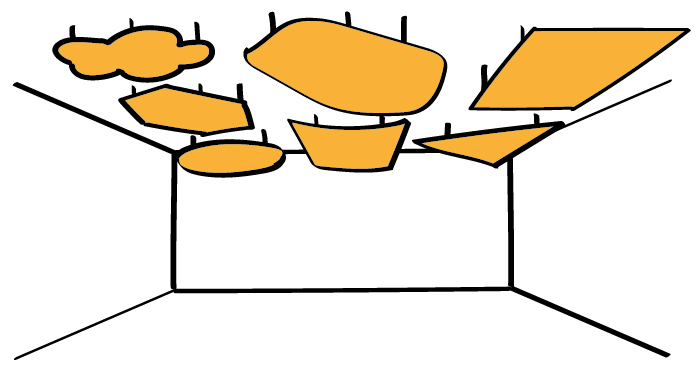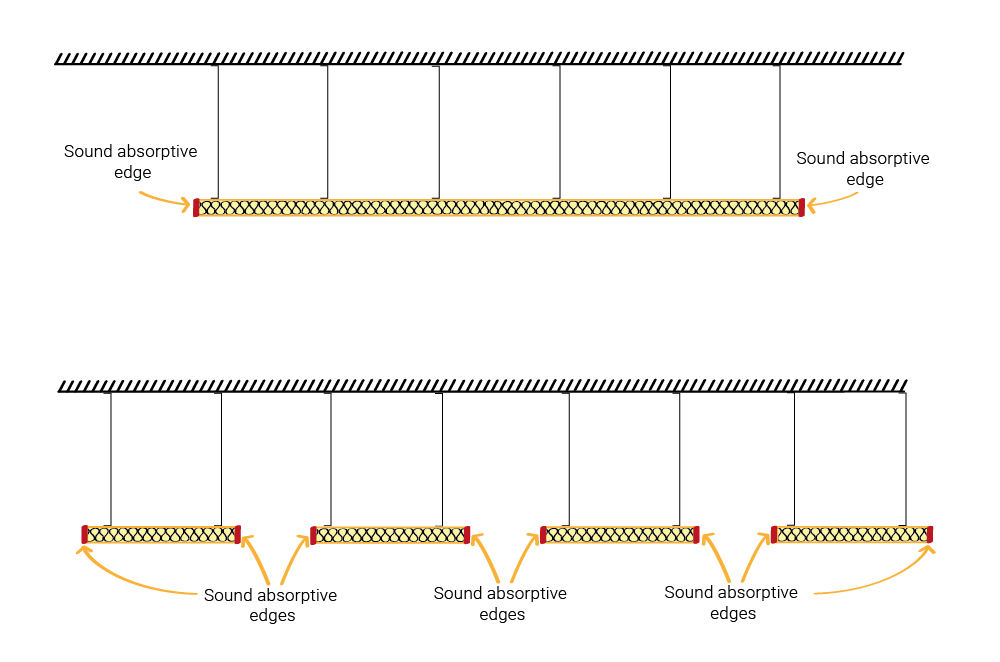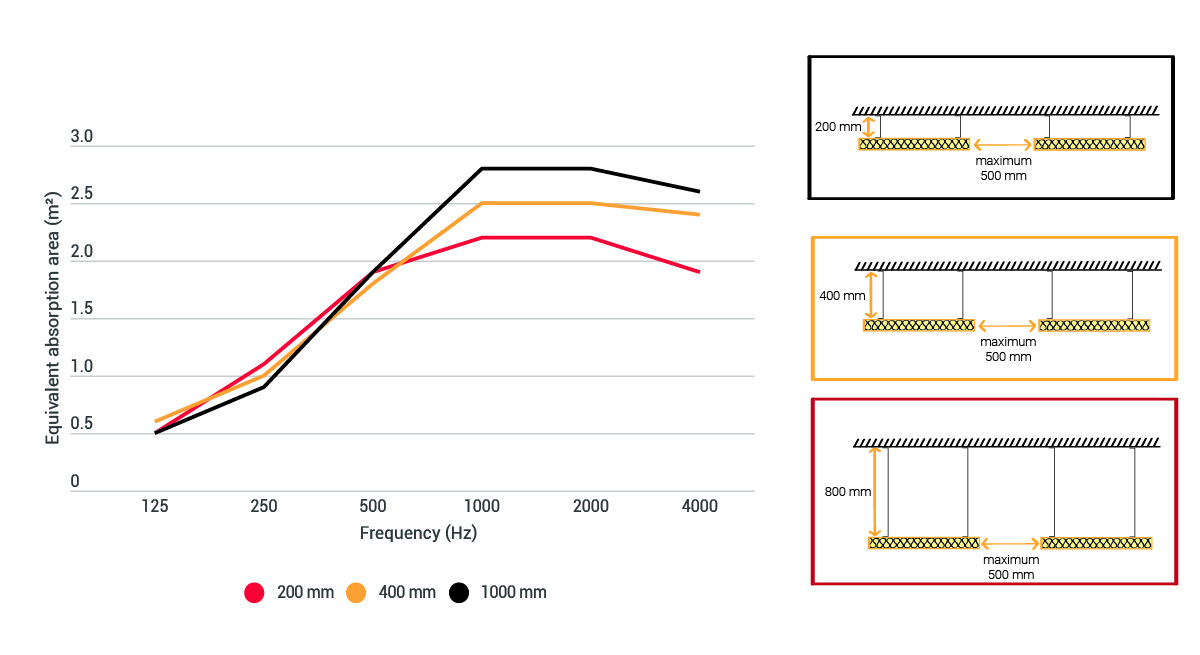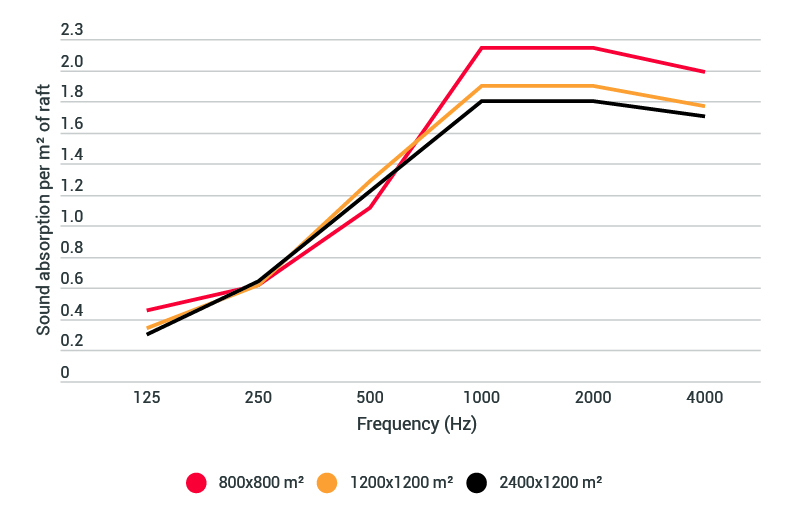
Have you ever wondered what suspended acoustic rafts are and how they acoustically work?
This page briefly explains:
- what suspended acoustic rafts are exactly
- which sound absorption performances acoustic rafts achieve and, most importantly, how they should be specified
- which materials are usually used for acoustic rafts
- examples of acoustics rafts products available on the market
Enjoy the read!
(See at the end the references used to confirm the concepts)

Do you want to be notified when new posts are published?
Why don’t you subscribe to Atelier Crescendo’s newsletter by clicking here?
What are suspended acoustic rafts?
Suspended acoustic rafts are free-hanging and flat elements made with a thick fibrous or porous materials that have sound absorption qualities. You hang them horizontally at a certain distance from a hard surface (usually a soffit).
They are a popular option to reduce the sound reverberation in:
- education spaces
- office spaces
- assembly spaces
- public spaces (such as receptions, entrance halls, etc)
Brief description of suspended acoustic raft systems

Although acoustic rafts are mostly square or rectangular, some of them are also round, oval or any other bespoke shape.
Some raft manufacturers/suppliers give the option to include lighting and other electrical systems within the rafts.
Sound absorption performance of suspended acoustic rafts
The sound absorptive materials used for suspended acoustic rafts generally achieve sound absorption Class A, Class B or Class C.
However, you should know that sound absorption classes are generally for a materials fixed to a hard surface with only one side visible. This side is the only one that absorbs sound. The other one doesn’t.
For acoustic rafts, it is a little bit different.
Suspended acoustic rafts – Sound absorption below and above
Not only the underside of the rafts absorbs sound, but also upper side indirectly.
Sound will first hit the hard surface above the acoustic rafts and then the upper side of the rafts.
Therefore, the distance between the rafts and the hard surface above has an influence on the sound absorption of the raft systems. Below approximately 1m, the further the rafts from the hard surface, the higher the sound absorption at mid and high frequencies.
Sound absorption below and above the rafts

Suspended acoustic rafts – Sound absorption of the edges
The edges of the rafts also absorb sound.
So a couple of large acoustic rafts absorb a little bit less sound than a few smaller acoustic rafts (with the same amount of absorptive materials).
Sound absorption of raft edges

Suspended acoustic rafts – Examples of sound absorption performances
To illustrate this, the graphs below shows examples of sound absorption performance for various raft systems.
Note
For rafts, the sound absorption performance is qualified in terms of equivalent absorption area per unit. Not in terms of sound absorption coefficient per m² of material.
Equivalent absorption area (m²) of 1200mm x 1200mm acoustic rafts located at different distances from the hard surface above 200 mm, 400 mm and 1000 mm and spaced 500 mm apart (Courtesy of Ecophon)

Sound absorption per m² of raft based on rafts of different sizes hung at 1000mm from the hard surface above (Courtesy of Ecophon)

Suspended acoustic rafts – Specification
Based on the above, you can now understand that the sound absorption characteristics of raft systems don’t just depend on the material of the rafts.
Therefore, in the acoustic specifications, it is important to include the following information:
- the sound absorption of the material installed in a room (when measured in line with ISO 354:2003 Acoustics — Measurement of sound absorption in a reverberation room)
- the size of the rafts
- the spacing between the rafts
- the distance between the rafts and the hard surface above.
Note
The above is applicable to any other free hanging suspended acoustic system.
Materials used for suspended acoustic rafts
The materials preferred for acoustic rafts are usually thick fibrous or porous sound absorptive materials such as:
- fibre glass
- mineral wool
- wood wool and mineral wool on top
- polyester fibres
- wood fibres
Sometimes, the sound absorptive material is wrapped in a fibrous fabric or even painted.
